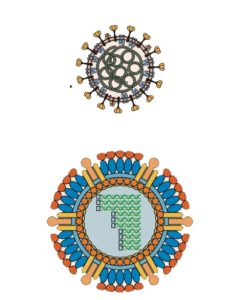

The unusual recombinant virus was identified in rectal swabs from Rousettus leschenaulti bats in Yunnan Province, China. Sequence analysis revealed a typical coronavirus genome with the exception of a small region near the 3′-end of the viral RNA with homology to a bat reovirus. This sequence, called p10, was also detected in viral mRNAs from infected bats, further demonstrating the presence of the reovirus-like gene in the coronavirus genome.
In bat reoviruses, the p10 gene is known to encode a protein that causes cell fusion. When the p10 gene from the bat coronavirus was expressed in cells, formation of syncytia (fused cells) was observed. Furthemore, the p10 protein was detected by western blot analysis of feces from infected bats. These results indicate that the p10 protein is produced from the viral genome and that the protein is functional.
This report is not the first suggesting recombination between viruses of different families – we discussed one example here previously (link to article), and there are a handful of other examples. The important question is how such inter-family recombinants arise. It must begin with co-infection of a host with two different viruses – in this case, likely a bat – but the precise molecular events are unknown. It might be useful to attempt to isolate such recombinants in cell culture to understand the underlying mechanisms.

Pingback: https://virology.ws/2016/10/27/genome-recombination-across-viral-families/ – Monkeying around
Other example http://onlinelibrary.wiley.com/doi/10.1111/nph.12650/full . In this case, it’s “just” an RNA element (translational element) located in the unstranslated region.